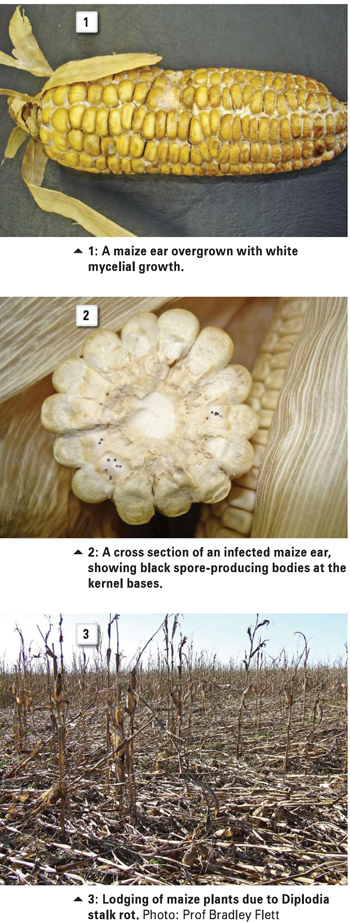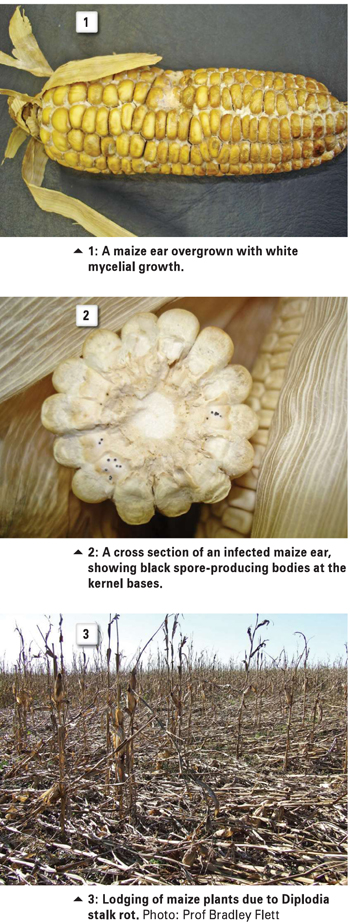December 2017
DR BELINDA JANSE VAN RENSBURG, ARC-Grain Crops, Potchefstroom and PROF VINESH MAHARAJ, Department of Chemistry, University of Pretoria
Diplodia stalk and ear rot is caused by the fungus Stenocarpella maydis and can be encountered throughout the world. Diplodia ear rot is usually noted in seasons with early drought followed by excessive and extended rainfall during the maturation stage of the maize plant. Diplodia stalk rots become common in seasons where early season rainfall is followed by a midseason drought period during grain fill.
Diplodia ear and stalk rot disease produces specific mycotoxins which have been shown to affect animals differently in various studies, many of which were originally determined in South Africa where field symptoms of diplodiosis were initially reported.
Diplodiosis is defined as a nervous disorder of cattle and sheep resulting from the ingestion of mouldy cobs infected by S. maydis.
The past
The first record of diplodiosis in South Africa is a report by Van der Bijl in 1914 in the region of the Mooi River in the KwaZulu-Natal province. He reported an outbreak of ‘sickness’ in cattle which was characterised by paralysis following grazing on harvested maize fields.
Over the past three decades in South Africa, various reports of diplodiosis in livestock were received from veterinarians and producers. However these outbreaks have not been confirmed to be caused by Diplodia contaminated residues.
The present
Stenocarpella maydis (Diplodia) ear rot
Drought during the early season, followed by rain during the late season, can lead to Diplodia ear rot epidemics, especially where high inoculum sources are present on stubble covering soil.
This fungus has the ability to produce spore producing structures that can survive on maize stubble through the winter while producing spores during spring.
 These spores then infect plants throughout the growing season. After rain or during high humidity, these structures release spores in the air, which land on maize plants and infect the base of the ear/leaf junction and ramifies upwards into the ear. The entire ear becomes overgrown with a white mycelial growth (Photo 1).
These spores then infect plants throughout the growing season. After rain or during high humidity, these structures release spores in the air, which land on maize plants and infect the base of the ear/leaf junction and ramifies upwards into the ear. The entire ear becomes overgrown with a white mycelial growth (Photo 1).
If a cross section is made of an infected ear, black spore-producing bodies at the kernel bases can be seen (Photo 2). Late season infections may occur when kernel moisture is low, but these symptoms are less obvious. Infections that show little or no symptoms are locally referred to as ‘skelm Diplodia’.
Diplodia ear rot can re-occur (epidemic) in certain areas and infected grain is then harvested with the healthy grain, thereby reducing grain quality. Reduced grain quality will have negative financial implications as this reduces the price the producer receives for his grain. During such an epidemic when early infections are present, yield losses can be of great economic importance.
Stenocarpella maydis (Diplodia) stalk rot
This fungus is common in all maize producing areas and in seasons with early rains and persisting late season droughts, this disease becomes very damaging, resulting in lodging and poor grain fill.
Diplodia stalk rot reduces yield by reducing nutrient and moisture uptake to ears during grain fill. This sink (the ear) extracts sugars from the stalk which further predisposes the stalk to fungal growth and further reduces nutrient uptake.
This continual sink-source cycle reduces yield. The onset of windy conditions whilst plants are drying results in lodging (Photo 3) and further economic losses as ears have to be picked by hand. Estimated annual yield losses of 5% to 20% may occur due to
Diplodia stalk rot and lodging.
The fungus overwinters in a mycelial form in maize stubble (buried or on the soil surface) throughout the winter. Under warm, moist conditions, pycnidia develop which release spores which are spread by wind and rain.
Infections of plants occur mainly through the crown and roots and occasionally at the nodes between the crown and ear. Infection usually takes place two to three weeks after silking under favourable conditions. Dry early season conditions followed by rain during silk formation favour Diplodia ear rot, whereas a wet early season followed by drier conditions or heat stress is likely to result in more severe Diplodia stem rot.
Stalk rot symptoms appear several weeks after silking. Leaves of infected plants wilt, become dry and appear greyish-green. Lower internodes become brown and spongy. Small, black fruiting bodies (pycnidia) cluster near the nodes of the rind.
The rind may also be covered by a white mycelial growth. The stalk pith discolours and disintegrates with vascular bundles remaining intact. This weakening of the stalk predisposes plants to lodging during strong winds and rain prior to harvest.
Control measures for Diplodia ear and stalk rots
It is critical that Diplodia ear and stalk rot control is seen holistically and that other control measures are included in an integrated control programme to manage both Diplodia ear and stalk rots.
Stubble reduction/retention
Control of Diplodia ear rot includes surface stubble reduction by means of grazing, burning, baling or ploughing in of surface maize stubble. As the fungus (S. maydis) survives on maize stubble and survives poorly in soil, any management practice that reduces levels of infected surface stubble will reduce inoculum concentrations in the field.
The removal of stubble for a single season and then resorting back to stubble retention practices, only reduces Diplodia ear rot for that specific season. Where stubble is present the following season, the risk of Diplodia ear rot will increase to its original level, should weather conditions be favourable.
Stress reduction
Avoid planting unrealistically high plant populations on marginal soils and in areas where there is a high probability of drought, leaf or alternate stalk rot disease conditions.
Ensure plant nutrition is adequate and balanced relative to the yield potential of the land or area to be planted. Unnecessary stressors on the crop may increase the potential for Diplodia stalk rot, which indirectly in the long term may increase inoculum levels on the land and under conditions favourable for Diplodia ear rots an epidemic may occur.
Crop rotation
Crop rotations reduce Diplodia ear rots by reducing inoculum levels in two ways. Firstly, a non-host for the fungus will not allow the fungus to persist for the season where maize is not grown. Secondly, a greater period (a season or two) between maize crops allows for a natural breakdown of maize stubble, which again reduces the survival of the fungus.
Leguminous crops, such as soybeans, dry beans, groundnuts and cowpeas are very good rotation crops. Other rotation crops that reduce Diplodia ear rots, are wheat and oats. Sunflowers do not significantly reduce Diplodia ear rots under experimental conditions. The reason for this has not yet been found.
Early harvesting
Early harvesting will reduce Diplodia ear rots as it reduces the time available for the fungus to grow on the ear. Late or winter rains keep ears wet and increase the chance for fungal growth. In certain cases, it would pay to harvest early at higher moisture levels and artificially dry grain. This is possibly why Diplodia ear rot is not a major problem in the USA where maize is harvested early and dried artificially.
Hybrid resistance
Selection of cultivars is very important in the control of Diplodia ear and stalk rots. In general, a resistant hybrid will always have less Diplodia ear rot than susceptible hybrids relative to prevailing conditions. This effect is an interaction between the available inoculum, the host and prevailing weather conditions.
However, there are many maize hybrids that react consistently over all localities, but there are some that do not. In a project funded by the Maize Trust, the local South African National Cultivar Trial entries of the ARC are used to screen maize hybrids annually for resistance/susceptibility to Diplodia ear rots under various weather and inoculum conditions. Diplodia inoculum is also supplied to companies for screening.
Resistance to Diplodia stalk rot is difficult to quantify as plant standability or resistance to lodging, does not necessarily mean the stalk is not infected with Diplodia stalk rot. It means that even though the stalk may be infected with Diplodia stalk rot, it will not lodge. Resistance therefore is not against the fungus, but by improving stalk rind thickness.
A thicker rind may still have Diplodia stalk rot which results in the breakdown of the stalk pith tissue within the rind. Thicker rinds may in the long term have the unintended effect of actually increasing Diplodia inoculum as it is more resistant to decomposition and may improve survival of the inoculum which from extensive studies has been shown to survive successfully in intact maize residues, particularly those retained on the soil surface. It is therefore important that Diplodia stalk rot resistance is seen in the correct context.
Diplodiosis and its associated toxins
Diplodiosis, a nervous disorder of cattle and sheep, results from the ingestion of ears infected by Diplodia. Cases of diplodiosis occur from six days to two weeks after the animals are placed on fields with infected maize cobs.
The disease is characterised by reluctance of the animals to move, a wide-based stance, inco-ordination, tremors, paralysis and death. The disease also causes abnormal foetal development and foetal death.
Field outbreaks of diplodiosis in southern Africa are favoured by late, heavy rains and occur during the late winter months (July to September). The practice of using harvested maize fields for winter grazing is a major contributing factor to outbreaks of this mycotoxicosis. In addition to diplodiatoxin, new metabolites, namely dipmatol, diplonine and chaetoglobosins K and L, have recently been isolated from Diplodia infected crops.
To date, none of these pure metabolites have been administered to ruminants in order to reproduce the disease. Laboratory analytical test methods that quantify and establish the presence and distribution of these toxins in infected maize commodities are also lacking.
The future
In a current Maize Trust funded project, the University of Pretoria (Departments of Chemistry and Veterinary Science), the Department of Biotechnology and Food Technology (TUT), South African Grain Laboratories (SAGL) and ARC-Grain Crops are currently collaborating in producing the various Diplodia mycotoxins in sufficient quantities to develop an analytical test for the detection of the metabolites in infected maize as well as to confirm Diplodiosis of these metabolites in target animals.
Who will benefit from this research?
Little research has been done internationally and this technology will give South African maize producers, livestock producers, regulatory authorities and final consumers a distinct advantage. The availability of an analytical test method will ensure that maize products supplied to the wide range of consumers are free of the mycotoxins rendering them safe.
Animal feed samples can be routinely tested for the presence of Diplodia mycotoxins and furthermore cases of diplodiosis can be confirmed or disproved enabling intervention methods. The technology will benefit the South African and international research community, enabling new avenues of research that will give practical solutions to all beneficiaries involved.
Publication: December 2017
Section: On farm level


















